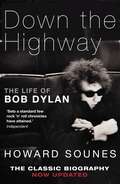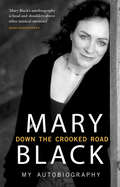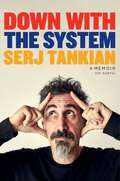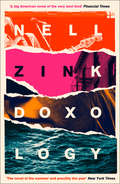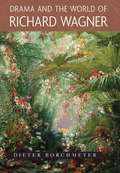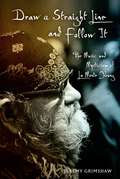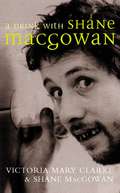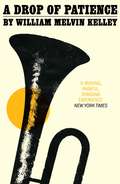- Table View
- List View
Dowland (Composers Across Cultures)
by K. Dawn GrapesDowland celebrates the story of one of the most important composers to emerge from early modern England. This book contextualizes the geographical, political, religious, cultural, and musical aspects of the life of John Dowland (1563-1626). It provides a window into life as a musician in the Elizabethan-Jacobean era, illuminating the importance of social, courtly, and academic connections as it closely explores the composer's musical compositions. During his lifetime, Dowland was well-known for his prowess as a performing lutenist who established a reputation not only in England, but also in the German and Italian lands, Denmark, and beyond. His lute solos and duos survive in manuscripts collected across Europe. He also issued four books of lute song-ayres, including the most successful secular music anthology of the era, one collection of consort music, and a theoretical translation, all printed in London. In these publications, Dowland utilized innovative print formats and set new standards for contemporary genres. Collectively, Dowland's compositions and writings present the self-styled image of a man always seeking more. This book places these activities within a biographical timeline of ongoing artistic, commercial, and reputational pursuits. As a complete record, Dowland captures the entrepreneurial resourcefulness of the foremost musician of his day, a performing composer who understood expected conventions, seized opportunities, and created a musical legacy that still stands firm 400 years after his death.
Dowland (Composers Across Cultures)
by K. Dawn GrapesDowland celebrates the story of one of the most important composers to emerge from early modern England. This book contextualizes the geographical, political, religious, cultural, and musical aspects of the life of John Dowland (1563-1626). It provides a window into life as a musician in the Elizabethan-Jacobean era, illuminating the importance of social, courtly, and academic connections as it closely explores the composer's musical compositions. During his lifetime, Dowland was well-known for his prowess as a performing lutenist who established a reputation not only in England, but also in the German and Italian lands, Denmark, and beyond. His lute solos and duos survive in manuscripts collected across Europe. He also issued four books of lute song-ayres, including the most successful secular music anthology of the era, one collection of consort music, and a theoretical translation, all printed in London. In these publications, Dowland utilized innovative print formats and set new standards for contemporary genres. Collectively, Dowland's compositions and writings present the self-styled image of a man always seeking more. This book places these activities within a biographical timeline of ongoing artistic, commercial, and reputational pursuits. As a complete record, Dowland captures the entrepreneurial resourcefulness of the foremost musician of his day, a performing composer who understood expected conventions, seized opportunities, and created a musical legacy that still stands firm 400 years after his death.
Down The Highway: The Life Of Bob Dylan
by Howard SounesThis new edition of Howard Sounes' classic and definitive biography of Bob Dylan now offers a new chapter that brings Dylan's story fully up to date for his seventieth birthday. First published to international critical acclaim in 2001, it gives a complete picture of the man as well as of the artist and performer. Based on in-depth original research,including hundreds of interviews with Dylan's closest associates, Down the Highway now also contains a fresh section covering the artist's most recent projects.A compelling, engagingly fast-paced and revelatory life, it takes the reader on a journey from Dylan's childhood in a Minnesota mining town to the status he enjoys today as the leading poet-troubadour of popular song, and one of the most iconic figures of contemporary culture.
Down the Crooked Road: My Autobiography
by Mary BlackFor the last thirty years, singer Mary Black has been a dominant presence on the Irish music scene, an award-winning artist with many bestselling albums to her name. Now, in this long-awaited memoir, Mary takes us back to the roots of her musical heritage and to the influences that helped to shape her as an artist and a woman. Born into a musical family, Mary Black – a feisty tomboy who could hold her own when it came to sparring with her brothers and anyone else brave enough to take her on – began singing folk songs from the age of ten. Music played an important role in the family home and, performing with her brothers and her sister Frances, Mary built her highly successful career on the bedrock of these early years. From the pubs and clubs of her hometown, Dublin, she went on to perform in some of the most prestigious venues across the world. Always committed to exploring new material from the best writers, her unique talent attracted acclaim from critics, fellow artists and the public alike. It also led to a host of bestselling albums, including the multi-platinum No Frontiers, which spent more than a year in the Irish Top 30. Mary’s love of singing was matched only by the love she had for her family. As she recalls the inevitable tensions that arose when trying to juggle family life and a high-profile career, she tells of her struggle to combine the two contrasting aspects of her life. It was only through gritty determination, hard work and a fair amount of laughter that Mary was able to enjoy major success as an artist and, at the same time, raise a close and loving family with her husband Joe. Refreshingly honest, and written with warmth and humour, Down the Crooked Road offers a unique insight into the life and career of one of our most gifted singers – an artist who, during the course of her long career, has captured the hearts of millions around the world.
Down with the System: The highly-awaited memoir from the System Of A Down legend
by Serj TankianThe incredible first memoir by System Of A Down frontman Serj TankianWith nearly 40 million record sales, three albums topping the Billboard charts, a Grammy win and a legion of fans, System Of A Down are one of the biggest metal bands on the planet. At their core has always been Serj Tankian, whose journey from the streets of Beirut to rock superstardom is as remarkable and unlikely as you'll get. By dint of luck, circumstance, struggle, and more than a little talent, Serj has had the chance to live an extraordinary life. In Down With the System, he retraces this remarkable and unlikely journey, and explores what it's taught him - about music, about art, about activism, and about himself. From teaming up with Tom Morello to push social justice causes on unsuspecting metalheads, arguing with LAPD officers over the best way to quell his rioting fans, and traveling with Anthony Bourdain through Armenia one meal at a time, Down With the System is an immigrant's tale, an activist's awakening, and rock memoir unlike any other.
Doxology: A Novel
by Nell ZinkTwo generations of an American family come of age – one before 9/11, one after – in this moving and original novel from the “intellectually restless, uniquely funny” (New York Times Book Review) mind of Nell Zink
D’Oyly Carte: The Decline and Fall of an Opera Company (Routledge Advances in Theatre & Performance Studies)
by Paul SeeleyThis book considers and discusses aspects of the management of the D’Oyly Carte Opera Company in the twentieth century since the death of its founder Richard D’Oyly Carte, and concentrates on key events that contributed to its demise in 1982. In this book, Paul Seeley follows the analytical model that proposes no single factor triggered the collapse, but rather several, both external and internal. In the case of an opera company the external factors may include public taste and market forces, but more significant are the internal factors such as the management decisions taken in response to external factors and how these compare with the original artistic aims, aspirations and business models of the founder. This is a study by someone with close observation of the administration; at the 1982 demise, Seeley was assistant to the company manager, having earlier served on the music staff. The book is a must-read for music historians, theatre historians and arts-management professionals; as an uncompromisingly critical history of the D'Oyly Carte Opera Company it is designed to serve a wider public, not just the Gilbert and Sullivan opera specialist, but anyone keen to debate the desirability of private or public sponsorship of the performing arts.
D’Oyly Carte: The Decline and Fall of an Opera Company (Routledge Advances in Theatre & Performance Studies)
by Paul SeeleyThis book considers and discusses aspects of the management of the D’Oyly Carte Opera Company in the twentieth century since the death of its founder Richard D’Oyly Carte, and concentrates on key events that contributed to its demise in 1982. In this book, Paul Seeley follows the analytical model that proposes no single factor triggered the collapse, but rather several, both external and internal. In the case of an opera company the external factors may include public taste and market forces, but more significant are the internal factors such as the management decisions taken in response to external factors and how these compare with the original artistic aims, aspirations and business models of the founder. This is a study by someone with close observation of the administration; at the 1982 demise, Seeley was assistant to the company manager, having earlier served on the music staff. The book is a must-read for music historians, theatre historians and arts-management professionals; as an uncompromisingly critical history of the D'Oyly Carte Opera Company it is designed to serve a wider public, not just the Gilbert and Sullivan opera specialist, but anyone keen to debate the desirability of private or public sponsorship of the performing arts.
A Dozen A Day: Book Three
by Burnam E-MA Dozen a Day: Book 3 Pre-practice technical exercises for the piano. The purpose of this book is to help develop strong hands and flexible fingers. The idea is to learn two or three exercises at a time, which should be played each day before practising. Only when these are mastered should you add another. When all in the first group are mastered, the next group may be introduced. Many of these exercises may be transposed to different keys.
A Dozen A Day: Book Two
by Burnam E-MA Dozen a Day: Book 2 Pre-practice technical exercises for the piano. The purpose of this book is to help develop strong hands and flexible fingers. The idea is to learn two or three exercises at a time, which should be played each day before practising. Only when these are mastered should you add another. When all in the first group are mastered, the next group may be introduced. Many of these exercises may be transposed to different keys.
Dāphā: Music, Performance and Meaning in Bhaktapur, Nepal (SOAS Studies in Music)
by Richard WiddessDāphā, or dāphā bhajan, is a genre of Hindu-Buddhist devotional singing, performed by male, non-professional musicians of the farmer and other castes belonging to the Newar ethnic group, in the towns and villages of the Kathmandu Valley, Nepal. The songs, their texts, and their characteristic responsorial performance-style represent an extension of pan-South Asian traditions of rāga- and tāla-based devotional song, but at the same time embody distinctive characteristics of Newar culture. This culture is of unique importance as an urban South Asian society in which many traditional models survive into the modern age. There are few book-length studies of non-classical vocal music in South Asia, and none of dāphā. Richard Widdess describes the music and musical practices of dāphā, accounts for their historical origins and later transformations, investigates links with other South Asian traditions, and describes a cultural world in which music is an integral part of everyday social and religious life. The book focusses particularly on the musical system and structures of dāphā, but aims to integrate their analysis with that of the cultural and historical context of the music, in order to address the question of what music means in a traditional South Asian society.
Dāphā: Music, Performance and Meaning in Bhaktapur, Nepal (SOAS Studies in Music)
by Richard WiddessDāphā, or dāphā bhajan, is a genre of Hindu-Buddhist devotional singing, performed by male, non-professional musicians of the farmer and other castes belonging to the Newar ethnic group, in the towns and villages of the Kathmandu Valley, Nepal. The songs, their texts, and their characteristic responsorial performance-style represent an extension of pan-South Asian traditions of rāga- and tāla-based devotional song, but at the same time embody distinctive characteristics of Newar culture. This culture is of unique importance as an urban South Asian society in which many traditional models survive into the modern age. There are few book-length studies of non-classical vocal music in South Asia, and none of dāphā. Richard Widdess describes the music and musical practices of dāphā, accounts for their historical origins and later transformations, investigates links with other South Asian traditions, and describes a cultural world in which music is an integral part of everyday social and religious life. The book focusses particularly on the musical system and structures of dāphā, but aims to integrate their analysis with that of the cultural and historical context of the music, in order to address the question of what music means in a traditional South Asian society.
Drama and the World of Richard Wagner (PDF)
by Dieter Borchmeyer Daphne EllisRichard Wagner continues to be the most controversial artist in history, a perpetually troubling figure in our cultural consciousness. The unceasing debate over his works and their impact--for and against--is one reason why there has been no genuinely comprehensive modern account of his musical dramas until now. Dieter Borchmeyer's book is the first to present an overall picture of these musical dramas from the standpoint of literary and theatrical history. It extends from the composer's early works--still largely ignored--to the Ring Cycle and Parsifal, and includes Wagner's unfinished works and operas he never set to music. Through lively prose, we come to see Wagner as a librettist--and as a man of letters--rather than primarily as musical composer.Borchmeyer uncovers a vast field of cultural and historical cross-references in Wagner's works. In the first part of the book, he sets out in search of the various archetypal scenes, opening up the composer's dramatic workshop to the reader. He covers all of Wagner's operas, from early juvenilia to the canonical later works.The second part examines Wagner in relation to political figures including King Ludwig II and Bismarck, and, importantly, in light of critical reactions by literary giants--Thomas Mann, whom Borchmeyer calls "a guiding light in this exploration of the fields that Wagner tilled," and Nietzsche, whose appeal to "philology" is a key source of inspiration in attempts to grapple with Wagner's works.For more than twenty years, Borchmeyer has placed his scholarship at the service of the famed Bayreuth Festival. With this volume, he gives us a summation of decades of engagement with the phenomenon of Wagner and, at the same time, the result of an abiding critical passion for his works.
Dramenmodell und ideologische Entwicklung der italienischen Oper im frühen Ottocento
by Fabian A. StallknechtIm Gegensatz zu landläufigen Vorstellungen, welche in der italienischen romantischen Oper lediglich einen klanglichen Konsumartikel ohne gesellschaftspolitische Relevanz sehen wollen, war das Musiktheater des frühen Ottocento ein wichtiges Spiegelbild weltanschaulicher und politischer Strömungen. Die Abhandlung zeichnet die künstlerische und thematisch-ideologische Entwicklung der italienischen Oper vor Verdi nicht nur unter historischen und ästhetischen Aspekten nach, sondern setzt das auf dem Musiktheater gestaltete Gesellschafsbild in Beziehung zu den politischen, ökonomischen und gesellschaftlichen Umwälzungen der Jahre 1815-1835. Über die dramaturgische Analyse wichtiger Werke des Romanticismo hinaus steht die Entwicklung der italienischen Oper vom höfischen Unterhaltungstheater zur bürgerlichen Opernindustrie mit allen künstlerischen, organisatorischen und ideologischen Konsequenzen im Zentrum der Betrachtung.
Draw a Straight Line and Follow It: The Music and Mysticism of La Monte Young
by Jeremy GrimshawRecognized as the patriarch of the minimalist movement-Brian Eno once called him "the daddy of us all"--La Monte Young remains an enigma within the music world, one of the most important and yet most elusive composers of the late twentieth century. Early in his career Young almost completely eschewed the conventional musical institutions of publishers, record labels, and venues, in order to create compositions completely unfettered by commercial concerns. Yet at the same time he exercised profound influence on such varied figures as Terry Riley, Cornelius Cardew, Andy Warhol, Yoko Ono, David Lang, The Velvet Underground, and entire branches of electronica and drone music. For half a century, he and his partner and collaborator, Marian Zazeela, have worked in near-seclusion in their Tribeca loft, creating works that explore the furthest extremes of conceptual audacity, technical sophistication, acoustical complexity, and overt spirituality. Draw A Straight Line and Follow It: The Music and Mysticism of La Monte Young stands as the first narrative study to examine Young's life and work in detail. The book is a culmination of a decade of research, during which author Jeremy Grimshaw gained rare access to the composer and his archives. Loosely structured upon the chronology of the composer's career, the book takes a multi-disciplinary approach that combines biography, musicology, ethnomusicology, and music analysis, and illuminates such seemingly disparate aspects of Young's work as integral serialism and indeterminacy, Mormon esoterica and Vedic mysticism, and psychedelia and psychoacoustics. Draw A Straight Line and Follow It is a long-awaited, in-depth look at one of America's most fascinating musical figures.
Draw a Straight Line and Follow It: The Music and Mysticism of La Monte Young
by Jeremy GrimshawRecognized as the patriarch of the minimalist movement-Brian Eno once called him "the daddy of us all"--La Monte Young remains an enigma within the music world, one of the most important and yet most elusive composers of the late twentieth century. Early in his career Young almost completely eschewed the conventional musical institutions of publishers, record labels, and venues, in order to create compositions completely unfettered by commercial concerns. Yet at the same time he exercised profound influence on such varied figures as Terry Riley, Cornelius Cardew, Andy Warhol, Yoko Ono, David Lang, The Velvet Underground, and entire branches of electronica and drone music. For half a century, he and his partner and collaborator, Marian Zazeela, have worked in near-seclusion in their Tribeca loft, creating works that explore the furthest extremes of conceptual audacity, technical sophistication, acoustical complexity, and overt spirituality. Draw A Straight Line and Follow It: The Music and Mysticism of La Monte Young stands as the first narrative study to examine Young's life and work in detail. The book is a culmination of a decade of research, during which author Jeremy Grimshaw gained rare access to the composer and his archives. Loosely structured upon the chronology of the composer's career, the book takes a multi-disciplinary approach that combines biography, musicology, ethnomusicology, and music analysis, and illuminates such seemingly disparate aspects of Young's work as integral serialism and indeterminacy, Mormon esoterica and Vedic mysticism, and psychedelia and psychoacoustics. Draw A Straight Line and Follow It is a long-awaited, in-depth look at one of America's most fascinating musical figures.
Drawn To Sound: Animation Film Music And Sonicity (PDF) (Genre, Music And Sound Ser.)
by Rebecca CoyleAlthough the study of animated films has blossomed over recent years, the contribution of soundtrack to the success of animated productions has not yet been comprehensively analysed. This text seeks to bring music, voice talent & sound design to the forefront of critical discussion.
Dream a Little Dream of Me: The Life of 'Mama' Cass Elliot
by Eddi Fiegel'The greatest white female singer ever' is how Boy George described pop icon Cass Elliot, the sixties diva who was at the epicentre of US popular culture and music during the Californian hippy movement. Hailed as America's answer to the Beatles, the Mamas and the Papas' hits such as 'California Dreamin' and 'Monday Monday' became the soundtrack of a generation. Cass's uniquely emotive voice, charismatic wit and outsized multicoloured kaftans singled her out as a popstar who refused to conform to traditional female stereotypes. When she left the Mamas and the Papas, she immediately had a top ten hit with her debut single, 'Dream a Little Dream of Me' and became the queen on Los Angeles society. Her Beverly Hills villa was the scene of legenday parties, becoming the second home of stars such as Jack Nicholson and Grace Slick, but there was a darker side to her fame - after years of continuous dieting and drug addiction, she died mysteriously in London at the age of 33. Including interviews with Cass's friends and family, co-band members Michelle Phillips and Denny Doherty, and many of the famous names who knew her, this is both an insightful biography of an extraordinary singer, and a fascinating glimpse into free-living, free-loving ideals of the sixties as the optimism of the flower-child generation was crushed by the Vietnam War. 'The product of over 100 interviews and four years of research across three continents, it's a fantastic read that goes way beyond thorough . . . Fiegel's fine, all-encompassing tome restores much of the great woman's dignity' - Mojo
Dreams of Germany: Musical Imaginaries from the Concert Hall to the Dance Floor (Spektrum: Publications of the German Studies Association #18)
by Neil Gregor Thomas IrvineFor many centuries, Germany has enjoyed a reputation as the ‘land of music’. But just how was this reputation established and transformed over time, and to what extent was it produced within or outside of Germany? Through case studies that range from Bruckner to the Beatles and from symphonies to dance-club music, this volume looks at how German musicians and their audiences responded to the most significant developments of the twentieth century, including mass media, technological advances, fascism, and war on an unprecedented scale.
Dreams of Love: Playing the Romantic Pianist
by Ivan RaykoffThe Romantic pianist - the solo pianist who plays nineteenth-century piano music - has become an attractive figure in the popular imagination, considering the innumerable artworks, literary works, and films representing this performer's seductive allure. Dreams of Love pursues a wide-ranging interdisciplinary approach to understanding the romantic pianist as a cultural icon, focusing on the role of technology in producing and perpetuating this mythology over the past two centuries. Sound recording and cinema have shaped the pianist's music and image since the early twentieth century, but these contemporary media technologies build upon practices established during the early nineteenth century: the influence of the piano keyboard on early telegraphs and typewriters, the invention of the solo recital alongside developments in photography, and the ways that piano design and the placement of the instrument on stage structure our viewing-listening perspectives. The concept of technology can be broadened to include the performance of gender and sexuality as further ways of making the pianist into an attractive cultural figure. The book's three sections deal with the touch, sights, and sounds of the Romantic pianist's playing as mediated through various forms of technology. Analyzing these persistent Liebesträume and exploring how they function can reveal their meaning for performers, audiences, and music lovers of the past and present too.
A Drink with Shane MacGowan
by Victoria Mary Clarke Shane MacGowanThis bibulous, drug-indulgent and anarchic rock legend was born on a small farm in Tipperary, won a scholarship to Westminster, was rapidly expelled, became a rent boy, then a central figure of punk and the hugely influential star of The Pogues. MacGowan's music, innovative and powerful, is as distinctive as his chaotic, breakdown-scarred, drug and alcohol-fuelled lifestyle. MacGowan has an enormous fan-base hungry for stories of his wild behaviour, but this is also a book that celebrates this unique and charming musician, and offers insight into his remarkable perspective on this world - and the next!
Drive-By Truckers’ Southern Rock Opera (33 1/3)
by Rien FertelThe Drive-By Truckers' Southern Rock Opera takes listeners on a road trip through the American South, with stops along mean old highways and soul-sucking swamps, iconic recording studios and doomed chartered jets, and even Heaven and Hell. Along the way, the Truckers attempt to untangle the mess that is southern history by exploring the contradictory, dualistic nature of the region.Like twin paths intersecting and diverging before meeting again, the opera's libretto focuses on the lives of two bands: the fictional Betamax Guillotine, a stand-in for the Truckers themselves, and Southern rock gods Lynyrd Skynyrd. Rien Fertel takes us for a ride along the Truckers' winding road through the opera's Southlands, a region filled with youthful rockstar aspirations, fatal crashes, the wreckage of one band gone too soon, and the ambitions of another wrestling with the great hope and tragedy that is America.
A Drop of Patience
by William Melvin KelleyAt the age of five, a blind African-American boy is handed over to a brutal state home. Here Ludlow Washington will suffer for eleven years, until his prodigious musical talent provides him an unlikely ticket back into the world.The property of a band, playing for down-and-outs in a southern dive, Ludlow's pioneering flair will take him to New York and the very top of the jazz scene - where his personal demons will threaten to drag him back down to the bottom.A Drop of Patience is the story of a gifted and damaged man entirely set apart - by blindness, by race, by talent - who must wrestle with adversity and ambition to generate the acceptance and self-worth that have always eluded him.

